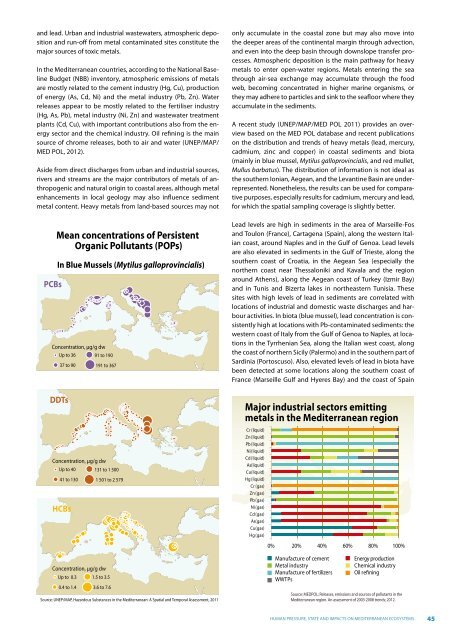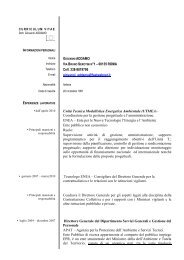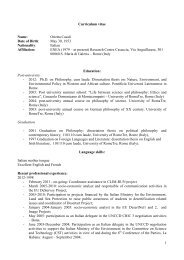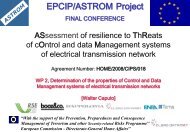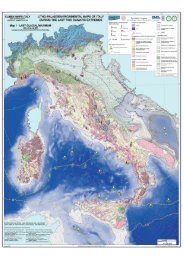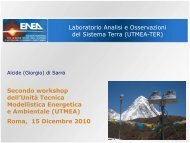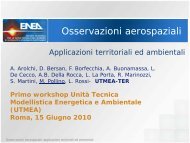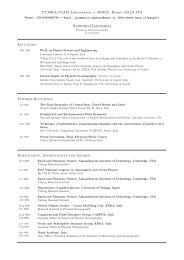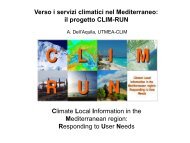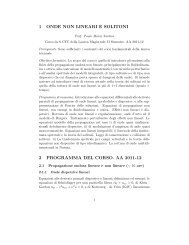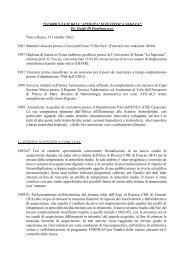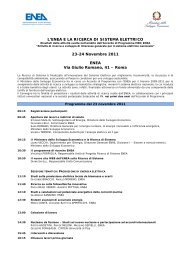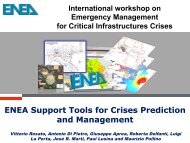State of the Mediterranean Marine and Coastal Environment
State of the Mediterranean Marine and Coastal Environment
State of the Mediterranean Marine and Coastal Environment
You also want an ePaper? Increase the reach of your titles
YUMPU automatically turns print PDFs into web optimized ePapers that Google loves.
<strong>and</strong> lead. Urban <strong>and</strong> industrial wastewaters, atmospheric deposition<br />
<strong>and</strong> run-<strong>of</strong>f from metal contaminated sites constitute <strong>the</strong><br />
major sources <strong>of</strong> toxic metals.<br />
In <strong>the</strong> <strong>Mediterranean</strong> countries, according to <strong>the</strong> National Baseline<br />
Budget (NBB) inventory, atmospheric emissions <strong>of</strong> metals<br />
are mostly related to <strong>the</strong> cement industry (Hg, Cu), production<br />
<strong>of</strong> energy (As, Cd, Ni) <strong>and</strong> <strong>the</strong> metal industry (Pb, Zn). Water<br />
releases appear to be mostly related to <strong>the</strong> fertiliser industry<br />
(Hg, As, Pb), metal industry (Ni, Zn) <strong>and</strong> wastewater treatment<br />
plants (Cd, Cu), with important contributions also from <strong>the</strong> energy<br />
sector <strong>and</strong> <strong>the</strong> chemical industry. Oil refining is <strong>the</strong> main<br />
source <strong>of</strong> chrome releases, both to air <strong>and</strong> water (UNEP/MAP/<br />
MED POL, 2012).<br />
Aside from direct discharges from urban <strong>and</strong> industrial sources,<br />
rivers <strong>and</strong> streams are <strong>the</strong> major contributors <strong>of</strong> metals <strong>of</strong> anthropogenic<br />
<strong>and</strong> natural origin to coastal areas, although metal<br />
enhancements in local geology may also influence sediment<br />
metal content. Heavy metals from l<strong>and</strong>-based sources may not<br />
Mean concentrations <strong>of</strong> Persistent<br />
Organic Pollutants (POPs)<br />
) In Blue Mussels (Mytilus galloprovincialis)<br />
PCBs<br />
Concentration, μg/g dw<br />
Up to 36 91 to 190<br />
DDTs<br />
37 to 90 191 to 367<br />
Concentration, μg/g dw<br />
Up to 40 131 to 1 500<br />
41 to 130 1 501 to 2 579<br />
HCBs<br />
Concentration, μg/g dw<br />
Up to 0.3 1.5 to 3.5<br />
0.4 to 1.4<br />
3.6 to 7.6<br />
Source: UNEP/MAP, Hazardous Substances in <strong>the</strong> <strong>Mediterranean</strong>: A Spatial <strong>and</strong> Temporal Assessment, 2011<br />
only accumulate in <strong>the</strong> coastal zone but may also move into<br />
<strong>the</strong> deeper areas <strong>of</strong> <strong>the</strong> continental margin through advection,<br />
<strong>and</strong> even into <strong>the</strong> deep basin through downslope transfer processes.<br />
Atmospheric deposition is <strong>the</strong> main pathway for heavy<br />
metals to enter open-water regions. Metals entering <strong>the</strong> sea<br />
through air-sea exchange may accumulate through <strong>the</strong> food<br />
web, becoming concentrated in higher marine organisms, or<br />
<strong>the</strong>y may adhere to particles <strong>and</strong> sink to <strong>the</strong> seafloor where <strong>the</strong>y<br />
accumulate in <strong>the</strong> sediments.<br />
A recent study (UNEP/MAP/MED POL 2011) provides an overview<br />
based on <strong>the</strong> MED POL database <strong>and</strong> recent publications<br />
on <strong>the</strong> distribution <strong>and</strong> trends <strong>of</strong> heavy metals (lead, mercury,<br />
cadmium, zinc <strong>and</strong> copper) in coastal sediments <strong>and</strong> biota<br />
(mainly in blue mussel, Mytilus galloprovincialis, <strong>and</strong> red mullet,<br />
Mullus barbatus). The distribution <strong>of</strong> information is not ideal as<br />
<strong>the</strong> sou<strong>the</strong>rn Ionian, Aegean, <strong>and</strong> <strong>the</strong> Levantine Basin are underrepresented.<br />
None<strong>the</strong>less, <strong>the</strong> results can be used for comparative<br />
purposes, especially results for cadmium, mercury <strong>and</strong> lead,<br />
for which <strong>the</strong> spatial sampling coverage is slightly better.<br />
Lead levels are high in sediments in <strong>the</strong> area <strong>of</strong> Marseille-Fos<br />
<strong>and</strong> Toulon (France), Cartagena (Spain), along <strong>the</strong> western Italian<br />
coast, around Naples <strong>and</strong> in <strong>the</strong> Gulf <strong>of</strong> Genoa. Lead levels<br />
are also elevated in sediments in <strong>the</strong> Gulf <strong>of</strong> Trieste, along <strong>the</strong><br />
sou<strong>the</strong>rn coast <strong>of</strong> Croatia, in <strong>the</strong> Aegean Sea (especially <strong>the</strong><br />
nor<strong>the</strong>rn coast near Thessaloniki <strong>and</strong> Kavala <strong>and</strong> <strong>the</strong> region<br />
around A<strong>the</strong>ns), along <strong>the</strong> Aegean coast <strong>of</strong> Turkey (Izmir Bay)<br />
<strong>and</strong> in Tunis <strong>and</strong> Bizerta lakes in nor<strong>the</strong>astern Tunisia. These<br />
sites with high levels <strong>of</strong> lead in sediments are correlated with<br />
locations <strong>of</strong> industrial <strong>and</strong> domestic waste discharges <strong>and</strong> harbour<br />
activities. In biota (blue mussel), lead concentration is consistently<br />
high at locations with Pb-contaminated sediments: <strong>the</strong><br />
western coast <strong>of</strong> Italy from <strong>the</strong> Gulf <strong>of</strong> Genoa to Naples, at locations<br />
in <strong>the</strong> Tyrrhenian Sea, along <strong>the</strong> Italian west coast, along<br />
<strong>the</strong> coast <strong>of</strong> nor<strong>the</strong>rn Sicily (Palermo) <strong>and</strong> in <strong>the</strong> sou<strong>the</strong>rn part <strong>of</strong><br />
Sardinia (Portoscuso). Also, elevated levels <strong>of</strong> lead in biota have<br />
been detected at some locations along <strong>the</strong> sou<strong>the</strong>rn coast <strong>of</strong><br />
France (Marseille Gulf <strong>and</strong> Hyeres Bay) <strong>and</strong> <strong>the</strong> coast <strong>of</strong> Spain<br />
Major industrial sectors emitting<br />
metals in <strong>the</strong> <strong>Mediterranean</strong> region<br />
Cr (liquid)<br />
Zn (liquid)<br />
Pb (liquid)<br />
Ni (liquid)<br />
Cd (liquid)<br />
As(liquid)<br />
Cu(liquid)<br />
Hg (liquid)<br />
Cr (gas)<br />
Zn (gas)<br />
Pb (gas)<br />
Ni (gas)<br />
Cd (gas)<br />
As(gas)<br />
Cu(gas)<br />
Hg (gas)<br />
0% 20% 40% 60% 80% 100%<br />
Manufacture <strong>of</strong> cement<br />
Metal industry<br />
Manufacture <strong>of</strong> fertilizers<br />
WWTPs<br />
Energy production<br />
Chemical industry<br />
Oil refining<br />
Source: MEDPOL; Releases, emissions <strong>and</strong> sources <strong>of</strong> pollutants in <strong>the</strong><br />
<strong>Mediterranean</strong> region. An assessment <strong>of</strong> 2003-2008 trends; 2012.<br />
HUMAN PRESSURE, STATE AND IMPACTS ON MEDITERRANEAN ECOSYSTEMS<br />
45


